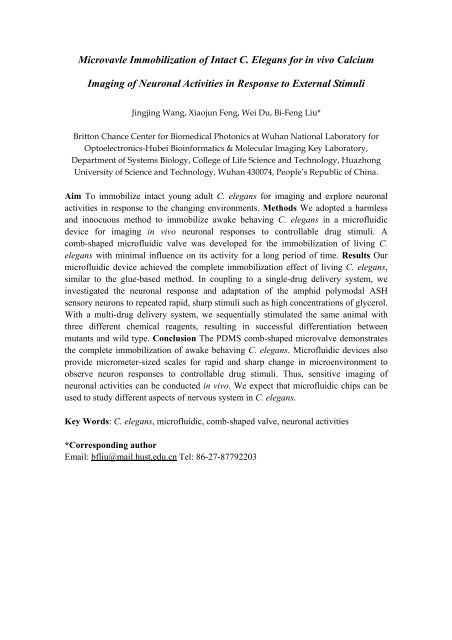New Modes of GPCR Signalling
New Modes of GPCR Signalling
New Modes of GPCR Signalling
You also want an ePaper? Increase the reach of your titles
YUMPU automatically turns print PDFs into web optimized ePapers that Google loves.
Microvavle Immobilization <strong>of</strong> Intact C. Elegans for in vivo Calcium<br />
Imaging <strong>of</strong> Neuronal Activities in Response to External Stimuli<br />
Jingjing Wang, Xiaojun Feng, Wei Du, Bi-Feng Liu*<br />
Britton Chance Center for Biomedical Photonics at Wuhan National Laboratory for<br />
Optoelectronics-Hubei Bioinformatics & Molecular Imaging Key Laboratory,<br />
Department <strong>of</strong> Systems Biology, College <strong>of</strong> Life Science and Technology, Huazhong<br />
University <strong>of</strong> Science and Technology, Wuhan 430074, People’s Republic <strong>of</strong> China.<br />
Aim To immobilize intact young adult C. elegans for imaging and explore neuronal<br />
activities in response to the changing environments. Methods We adopted a harmless<br />
and innocuous method to immobilize awake behaving C. elegans in a micr<strong>of</strong>luidic<br />
device for imaging in vivo neuronal responses to controllable drug stimuli. A<br />
comb-shaped micr<strong>of</strong>luidic valve was developed for the immobilization <strong>of</strong> living C.<br />
elegans with minimal influence on its activity for a long period <strong>of</strong> time. Results Our<br />
micr<strong>of</strong>luidic device achieved the complete immobilization effect <strong>of</strong> living C. elegans,<br />
similar to the glue-based method. In coupling to a single-drug delivery system, we<br />
investigated the neuronal response and adaptation <strong>of</strong> the amphid polymodal ASH<br />
sensory neurons to repeated rapid, sharp stimuli such as high concentrations <strong>of</strong> glycerol.<br />
With a multi-drug delivery system, we sequentially stimulated the same animal with<br />
three different chemical reagents, resulting in successful differentiation between<br />
mutants and wild type. Conclusion The PDMS comb-shaped microvalve demonstrates<br />
the complete immobilization <strong>of</strong> awake behaving C. elegans. Micr<strong>of</strong>luidic devices also<br />
provide micrometer-sized scales for rapid and sharp change in microenvironment to<br />
observe neuron responses to controllable drug stimuli. Thus, sensitive imaging <strong>of</strong><br />
neuronal activities can be conducted in vivo. We expect that micr<strong>of</strong>luidic chips can be<br />
used to study different aspects <strong>of</strong> nervous system in C. elegans.<br />
Key Words: C. elegans, micr<strong>of</strong>luidic, comb-shaped valve, neuronal activities<br />
*Corresponding author<br />
Email: bfliu@mail.hust.edu.cn Tel: 86-27-87792203












